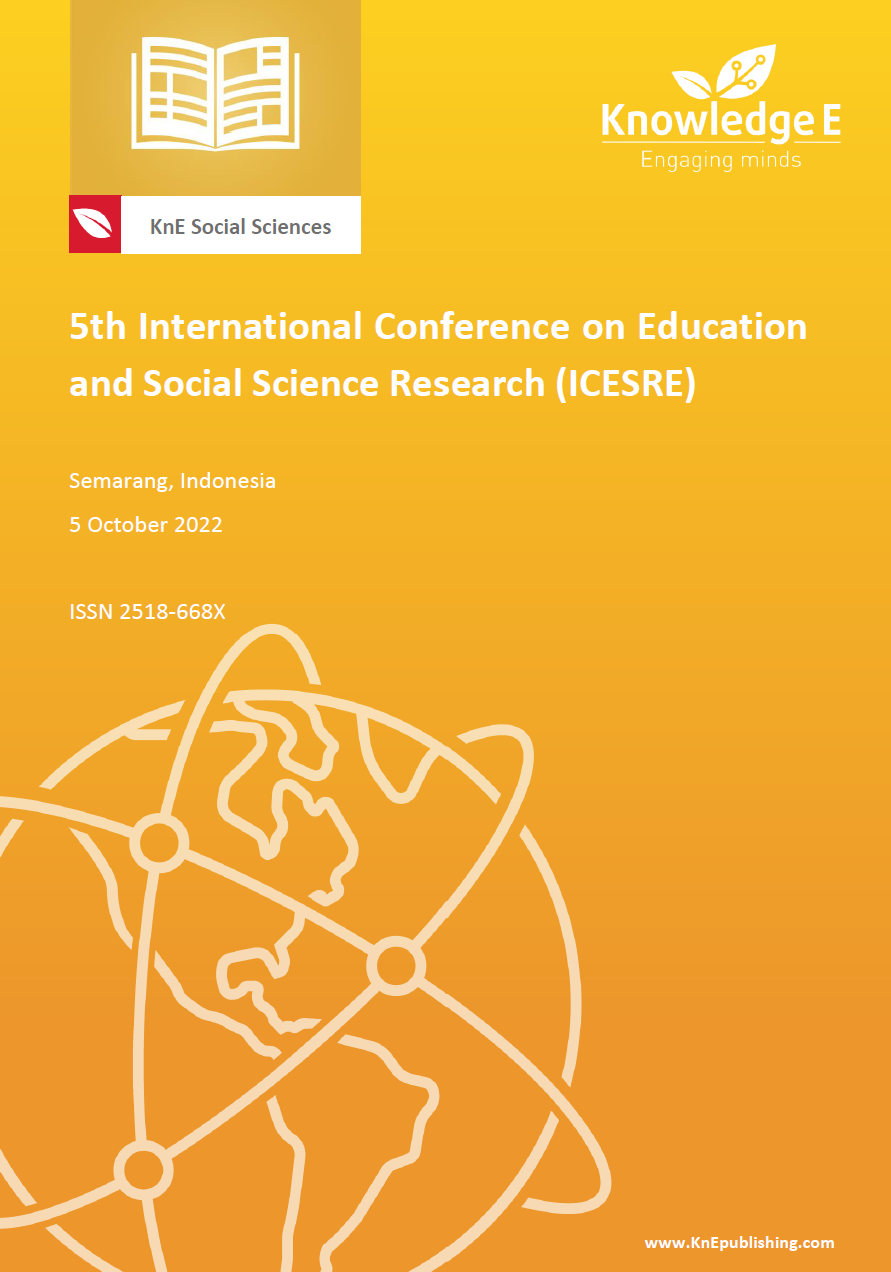Mobile Application to Improve Student Minimum Competency Assessment
DOI:
https://doi.org/10.18502/kss.v7i19.12471Abstract
This paper aims to assess whether understanding of the Minimum Competency Assessment (AKM) improves when taught to students through mobile learning. The research method was adapted from a development model whose stages consist of Analysis, Design, Development, Implementation, and Evaluation, but only carried out until the third stage (Development). Material experts and media experts carried out validation. The results show that the mobile application that has been developed was scored 87.88% in the ‘Very Good’ category by the media experts and was scored 89.62% in the ‘Very Good’ category by the material experts. Based on the results of data acquisition, it is shown that the mobile application is feasible to be used as a valid source to introduce students to AKM.
Keywords: Media Development, Mobile Application, Minimum Competency Assesment
References
[2] OECD. PISA for development assessment and analytical framework: Reading, mathematics and science, preliminary version. Paris: OECD Publishing; 2017.
[3] Cahyanovianty AD, Wahidin W. Analisis kemampan numerasi peserta didik kelas VIII dalam menyelesaikan soal asesmen kompetensi minimum (AKM). Jurnal Cendekia: Jurnal Pendidikan Matematika. 2021;5:1439–1448.
[4] Indah N, Mania S, Nursalam N. Peningkatan Kemampuan literasi matematika siswa melalui penerapan model pembelajaran problem based learning di kelas VII smp negeri 5 pallangga kabupaten gowa. MaPan. 2016;4:200–210.
[5] Mansur N. Melatih literasi matematika siswa dengan soal PISA. Prisma. 2018;1:40– 144.
[6] Abildinova GM, Alzhanov AK, Ospanova NN, Taybaldieva Z, Baigojanova DS, Pashovkin NO. Developing a mobile application “education process remote management system” on the android operating system. International Journal of Environmental and Science Education. 2016;11:5128–5145.
[7] Liu M, Horton L, Lee J, Kang J, Rosenblum J, O’Hair M, et al. Creating a multimedia enhanced problem-based learning environment for middle school science: Voices from the developers. Interdisciplinary Journal of Problem-Based Learning. 2015;8;81–91.
[8] Fauziah A, Sobari EFD, Robandi B. Analisis pemahaman guru sekolah menengah pertama (SMP) mengenai asesmen kompetensi minimum (AK M). Edukatif: Jurnal Ilmu Pendidikan. 2021;3:1550–1558.
[9] Purwati PD, Faiz A, Widiyatmoko A. Asesmen kompentensi minimum (AKM) kelas jenjang sekolah dasar sarana pemacu peningkatan literasi peserta didik. SOSIO RELIGI: Jurnal Kajian Pendidikan Umum. 2021;19.
[10] Sari A, Daulay S, Yola Yuliani Putri PE. Penghapusan Ujian Nasional Tahun 2021 Dalam Perspektif Guru sma di kota tebing tinggi. Seminar Nasional PBSI-III. 2020:213–220.
[11] Mendikbud. AKM dan implikasinya pada pembelajaran. Pusat Asesmen Dan Pembelajaran Badan Penelitian Dan Pengembangan Dan Perbukuan Kementerian Pendidikan Dan Kebudayaan. 2020;1–37.
[12] OECD. PISA 2015. 2015. Available from: https://www.oecd.org/pisa/pisa-2015-resultsinfocus. pdf.https://www.oecd.org/pisa/pisa-for-development/PISA-D-assessmentand- Analytical-Framework-Ebook.pdf
[13] Wilson M. Making measurement important for education: The crucial role of classroom assessment. Educational Measurement: Issues and Practice. 2018;37:5–2.
[14] Pellegrino JW. Assessment as a positive influence on 21st century teaching and learning: A systems approach to progress. Psicologia Educativa. 2014;20;65–77.
[15] Baird JA, Andrich D, Hopfenbeck TN, Stobart G. Assessment and learning: Fields apart? Assessment in Education: Principles, Policy and Practice. 2017;24:317–350.
[16] Brown GTL. Is assessment for learning really assessment? Frontiers in Education. 2019;4:1–7.
[17] Yau YW, Li Z, Chua MT, Kuan WS, Chan GWH. Virtual reality mobile application to improve videoscopic airway training: A randomised trial. Annals of the Academy of Medicine of Singapore. 2021;50;41–58.
[18] Liliarti N, Kuswanto H. Improving the competence of diagrammatic and argumentative representation in physics through android-based mobile learning application. International Journal of Instruction. 2018;11:107–122.
[19] Keane T, Keane W, Blicblau AS. Beyond traditional literacy: Learning. 2014.
[20] Cahya SD, Handayaningrum W. Aplikasi perfect ear sebagai media inovatif belajar teori musik. EDUTECH. 2018;19:173–184.
[21] Yaniawati P, Maat SM, Supianti II, Fisher D. Mathematics mobile blended learning development: Student-oriented high order thinking skill learning. European Journal of Educational Research. 2022;11:69–81.
[22] Alfan DC, Saptono S, Lisdiana L. Effectiveness of e-supplement mobile Android application toward science literacy skills on minimum competency assessment oriented in respiratory system of junior high school students. Journal of Innovative Science Education. 2022;129–135.
[23] Sudijono A. Pengantar statistik pendidikan. Jakarta: PT. Raja Grafindo Persada; 2006. Available from: https://www.academia.edu/37436922/ pengantar_statistik_pendidikan_anas_sudijono_34761_pdf
[24] Purwanto N. Prinsip-prinsip dan teknik evaluasi pengajaran. Bandung: PT. Remaja Rosdakarya. 2013. Available from: https://onesearch.id/Record/IOS3763.001238
[25] Wingnjosoebroto S, Sudiarno A, Harenda D. Perancangan interface prototype web berdasarkan pada aspek usability (Studi kasus: Laboratorium ergonomi dan perancangan sistem kerja teknik industri ITS). 2009.
[26] Rahadi DR. Pengukuran usability sistem menggunakan use questionnaire pada aplikasi android. JSI: Jurnal Sistem Informasi (E-Journal). 2014;6.

